My parents gave me two middle names so the intensity of their tone increased as each name was added to their beckoning call of “GET IN HERE NOW!”
Their tone conveyed all the meaning I needed to know as to whether or not I should consider running for the hills.
However, if my sister used the same technique on me it didn’t work. In fact, it often had the opposite effect — instead of foreboding, I found it humorous.
Why is it that her voice didn’t carry the same authority, even if she employed the same tone?
To understand how to use tone for maximum impact you’ll want to follow these steps:
- Understanding Voice and Tone
- Determine Your Voice
- Tone Types: Visual & Verbal
- Determine the Right Tone
- Creating Tone
- Tone Extends From URL to IRL
- Tone in Use
Create Your Brand Personality
UNDERSTANDING VOICE AND TONE
A recent study revealed that within just 7 months infants can distinguish human voices from other kinds of sounds and can even extract the emotional meaning that’s being expressed through vocal inflection.
In fact, Anne Cutler, a psycholinguist and professor at the Marcs Institute for Brain, Behaviour and Development at Western Sydney University states that infants recognize voices they heard while in the womb and gravitate toward familiar voices — like those from their mothers — over strangers.
Now the million-dollar question — Can your audience recognize yours?
Voice
Consider this, no matter who you communicate with, whether it’s family, friends, or strangers, you have a certain voice.
We’re not talking about the sound or pitch of your speech, although that is a part of it. Instead, we are focusing on your personality.
A brand is no different.
Each brand’s voice is distinct and shows their personality. This component should be consistent and unchanging.
Voice is a unique expression of your brand through the words you choose.
Applying particular tones within your voice can change the quality of the message, yet the voice remains the foundation of the messaging itself.
Your brand’s voice helps establish a connection with your audience. It helps you to share your values, attitudes, and motivations.
A successful brand voice helps to engage your audience and helps them to believe in what your brand stands for.
How you communicate with your audience is defined by the style of communication that fits your brand’s personality.
This helps to create a style that is authentic and fits your brand’s ideals, rather than simply trying to appeal to the current cultural zeitgeist.
Remember, trends come and go, but values should be the pillars of your brand — stable and able to endure change.
Just as you have a certain way of communicating and relating to family, friends, and acquaintances, your brand should also have a way to relate and communicate with your audience.
Your audience will be able to tell when you’re pandering and when you’re truly committed to what you say.
This is why your voice is so important.
In the end, your brand’s voice is less about what you choose to say and much more about how you choose to say it.
- There are many ways you will communicate with your audience:
Email
Website Content
Product Packaging
Ads
Social Media
- Each brand’s voice conveys:
Brand Personality
Rhythm and Pacing
Vocabulary or Terminology
Determine your voice
- Consider your audience
Know your audience well and how they communicate. But also, be okay with alienating those not in your target audience.
Remember, a man who chases two rabbits loses them both, so trying to please everybody pleases no one.
- Gather samples of your content, create a voice mood board, and look for patterns.
- Use three words to describe your brand — it can help to think of it as a person and how you’d describe them to a stranger.
Tone
Tone, on the other hand, can be applied to your voice to create a unique emotional inflection.
Essentially, if voice is what you say, tone is how you say it.
Tone is a powerful tool to convey the attitudes, beliefs, values, and personalities in the simplest of messages.
Take for example these two pieces of music:
Can you identify the emotion or mood in each? What is the message being conveyed?
Tone Types: Visual & Verbal
Tone isn’t all about words, it’s also about imagery too.
In art, tone can be created using a technique called chiaroscuro (Italian for light-dark) which refers to how light and shade are used.
Take these two pieces of art for instance:

Can you see how the use of color, lighting, and composition creates a tone that expresses very specific moods?
How to determine the right tone
Know your Brand Personality
Your Tone of Voice reflects your brand personality.
This will not only influence how you speak to customers, but also the copy on your website, social media captions, responses on comments, and marketing collateral.
Look at the example below. See how each different brand personality compares and how each matches a specific tone to create a unique style of voice.
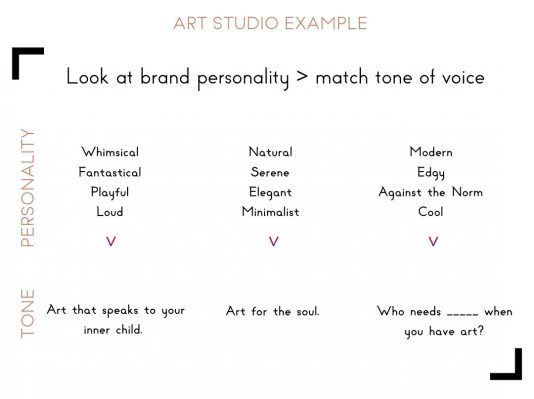
Consider what type of content you’re creating and the purpose of that content.
Tone can be thought of as how you use your voice to fit the appropriate situation.
While you wouldn’t take a humorous tone while giving a eulogy, you also wouldn’t take a somber tone while giving a speech at your best friend’s wedding.
Think about the two pieces of music in the example above, which would you play at a funeral, and which would you play at your friend’s wedding?
Using an inappropriate tone can have terrible consequences.
Don’t you take that tone with me! – Every Parent Ever
Chances are if you’re a human person you’ve heard this phrase at some point in your life.
While you might have gotten the opportunity to correct your incorrect tone with your parents, your audience won’t be so forgiving.
Brands can’t afford the cost of getting this wrong because your audience will likely not give you a second chance.
Utilize the right tone style techniques
There is a difference between light and friendly vs dark and moody. Understanding how to develop the right style can ensure you have the right tone.
To do this you need to understand three-component to tone style:
Etymology – finding the best words for your intended meaning.
Sound – how they are pronounced.
Syntax – how those words are arranged. Are they staccato (articulated and separate) or dense?
Consider getting professional copy to ensure your tone has the maximum impact.
Provide your team with the right tools to represent your brand well. – Create a style guide to ensure consistency.
This way, as you add new members to your team, or if you have a sick day, you won’t have to worry that the content being shared goes completely against what you’re trying to achieve.
Conduct an Audience Survey
Create polls that ask how your audience perceives your brand. Some possible questions:
- How would you describe our brand?
- If our brand were a person, how would they sound?
- Do you feel our tone is appropriate?
Research your Audience
Choose five of your best customers and Google them.
Then check out their activity on social media to understand their interests:
- Do they share a lot of memes or educational articles?
- How do they write (formal or casual)?
- What do they read and consume (do they like documentaries or do they watch fantasy films)?
CREATING TONE
Create a Brand Voice Chart
Getting your team on the same page and consistent in their presentation of your brand is key.
One way to do this is by performing a “We’re This, Not That” Exercise.
Essentially, fill in the blanks in “We’re _______ , but we’re not _______ .”
Try and come up with 3-5 traits.
From there create a chart using rows associated with the primary characteristics of your brand accompanied by three columns.
The first column is used to describe each of your primary brand characteristics, followed by a column for “do’s” and “don’ts.”
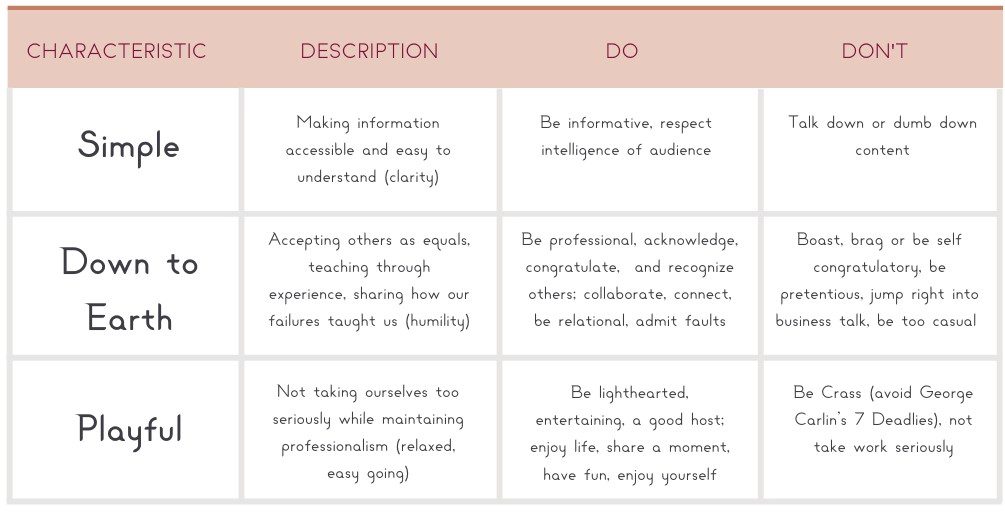
Tone Extends from URL to IRL
Remember, branding extends to every part of your business, not just your online presence.
People are influenced by the tone you choose everywhere you go.
It’s the URL space as well as the IRL (in real life) arena that carries your tone.
How you dress and speak and the scripts you provide your team when they are out selling or networking can all influence your reputation. The presentation in each of these areas has to carry a consistent tone.
TONE IN USE
How it’s Written (Caps vs Lowercase, Font Weight, Style)
Now that you have your tone identified you can employ a number of techniques.
For example, what typography you choose and the font weights and styles included in that typography can affect the tone.
Look at these examples:
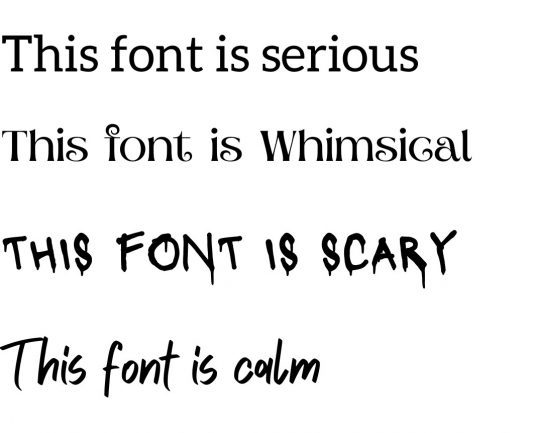
How it Looks (Color/Composition)
Color can also create tone as well.
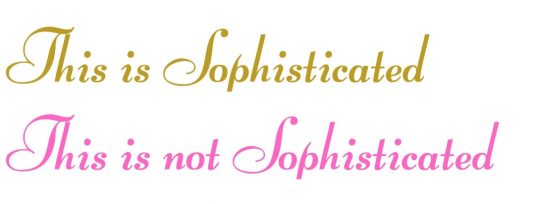
CONCLUSION
Begin by establishing your mission and values and emphasize your unique value that your brand has over your competition.
To do so, first choose three distinct traits that your brand has.
Remember, brand is your company reputation so consider how you’d like your audience to perceive it and what mood you need to create to have the desired effect.
Look at your demographic data from your social media and website analytics.
Who is resonating with your brand? Is it the right audience?
If not, you may want to reconsider how you craft your message using a different tone.
After all, when your tone is right it carries brand authority and keeps your brand out of trouble.
Need help developing your Brand’s Voice?
I’d Like to Hear from You
What’s your #1 takeaway from today’s article? Or what’s one question you have about what you read? Either way, I’d love to hear what you have to share so leave me comment below and let’s chat.
Key Takeaways
Brand Tone of Voice FAQs
What is the Difference between Brand Voice and Tone?
Essentially, if Voice is what you say, Tone is how you say it.
No matter who you communicate with, whether it’s family, friends, or strangers, you have a certain voice. This isn’t referring to the sound or pitch of your speech, although that is a part of it, we’re instead it is focused on your personality.
Voice is a unique expression of your brand through the words you choose.
Tone, on the other hand, can be applied to your voice to create a unique emotional inflection. Applying particular tones within your voice can change the quality of the message, yet the voice remains the foundation of the messaging itself.
What are the Types of Tones?
There are two types of Tone — Visual and Verbal.
Tone isn’t all about words, it’s also about imagery too.
When it comes to verbal tone you can choose light-hearted phrases or go a more bold route.
In art, tone can be created using a technique called chiaroscuro (Italian for light-dark) which refers to how light and shade are used. Visual tone is expressed through the contrast of light vs dark in your images.
How can I determine the right Tone for my Brand?
Know your Brand Personality.
Consider what type of content you’re creating and the purpose of that content.
Utilize the right tone style techniques.
Consider getting professional copy to ensure your tone has the maximum impact.
Conduct an Audience Survey.
Research your Audience.
What are the Three components of Tone Style?
Etymology – finding the best words for your intended meaning.
Sound – how they are pronounced.
Syntax – how those words are arranged. Are they staccato (articulated and separate) or dense?
How can I create a proper Tone for my Brand?
First, create a Brand Voice Chart.
Conduct a “We’re This, Not That” Exercise. Essentially fill in the blanks in “We’re _______ , but we’re not _______ .”
Try and come up with 3-5 traits.
From there create a chart using rows associated with the primary characteristics of your brand accompanied by three columns. The first column is used to describe each of your primary brand characteristics, followed by a column for “do’s” and “don’ts.”
Where should Brand Tone be used?
People are influenced by the tone you choose everywhere you go.
It’s the URL space as well as the IRL (in real life) arena that carries your tone.
In the digital space, this consists of anything from Email, Website Content, Product Packaging, Ads, and Social Media.
However, everything from how you dress and speak, to the scripts you provide your team when they are out selling or networking can all influence your reputation. The presentation in each of these areas has to carry a consistent tone.
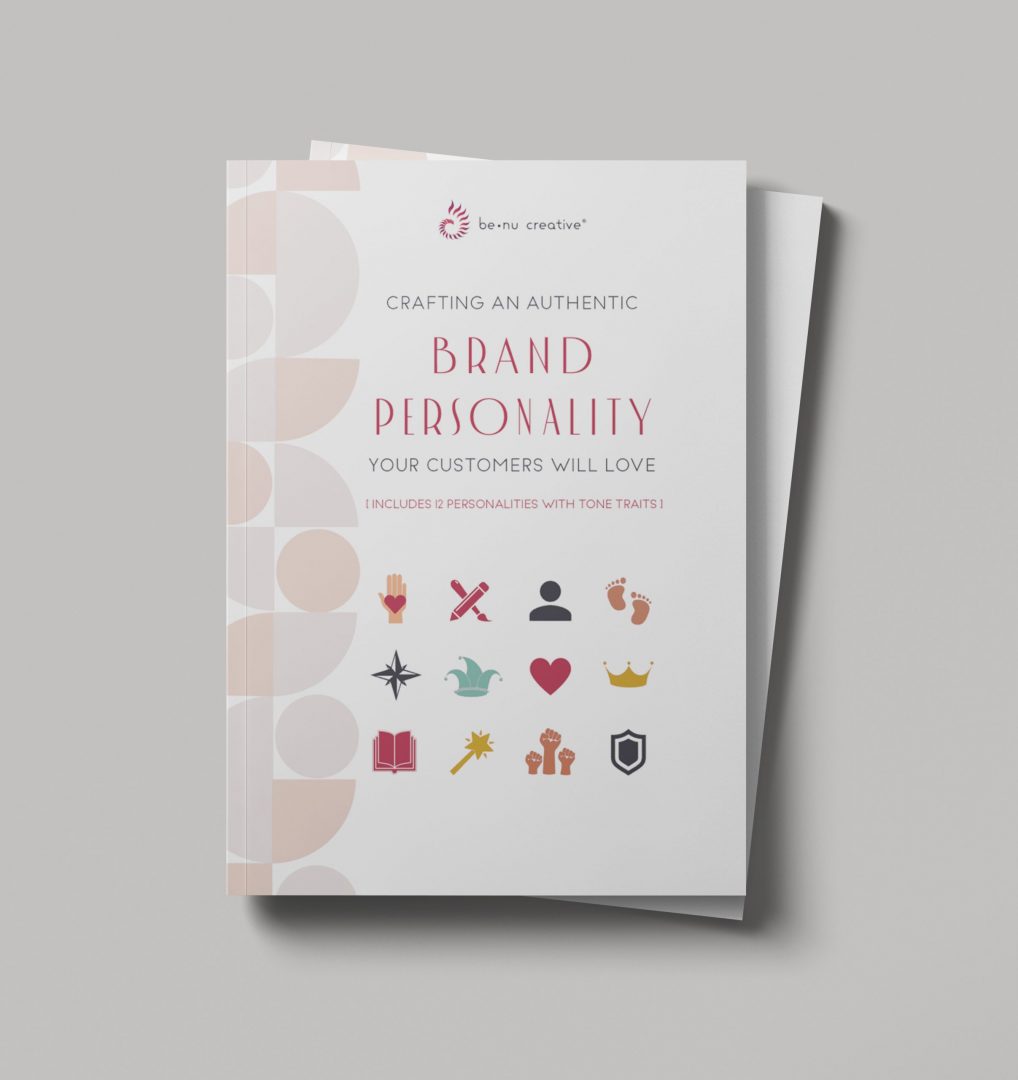

![Building Brand Recognition Like a Pro [Step by Step Guide]](https://benucreations.com/wp-content/uploads/2020/08/Benu-Creative-Branding-and-marketing-strategies-building-brand-recognition-step-by-step-guide-400x250.jpg)
![Crafting An Authentic Brand Personality Your Customers Will Love [ 12 Personalities ]](https://benucreations.com/wp-content/uploads/2021/12/Brand-Personality-Types-400x250.jpg)

![How To Do A SWOT Analysis [Free Template]](https://benucreations.com/wp-content/uploads/2020/12/Benu-Creative-How-to-Do-a-Competitor-Analysis-How-to-do-a-SWOT-Analysis-Branding-and-Marketing-Strategies-How-to-Brand-Your-Business-Building-Brand-Awareness-Building-Brand-Recognition-400x250.jpg)
0 Comments